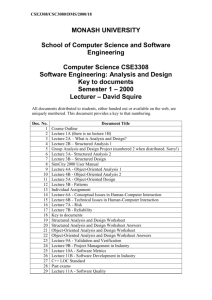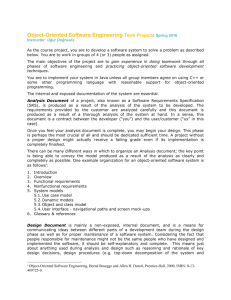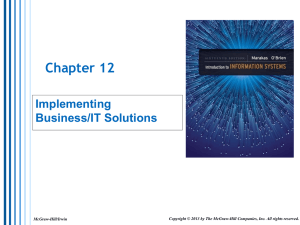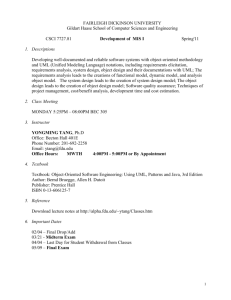Data Mining and Data Warehousing
advertisement
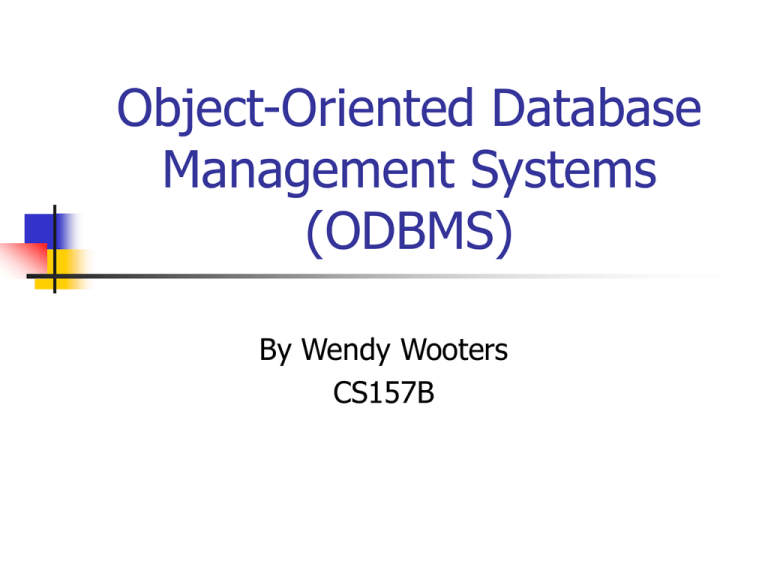
Object-Oriented Database
Management Systems
(ODBMS)
By Wendy Wooters
CS157B
ODBMS Outline
Definition
Persistent Programming Languages
Object-Oriented Concepts
Why
Who
Approaches
Object
Class & Encapsulation
Inheritance & Polymorphism
Object Identifier (OID)
Advantages and Disadvantages
Example Code
Conclusion
What is an ODBMS?
Database that stores data elements
as objects. Uses object-oriented
concepts.
Object - like an entity in and E-R
Diagram.
SSN
Hired
Name
Salary
Employee
Why use ODBMS?
Product DB
Complex data or
relationship requirements
Lack of unique, natural
identification
Large numbers of many to
many relationships
Access using traversals.
Graph/Tree structure.
Frequent use of type codes
such as those found in the
relational schema
Source: http://www.service-architecture.com/object-oriented-databases
Who Uses ODBMS?
Typical Applications for ODBMS:
Computer-aided design (CAD)
Computer-aided software engineering
(CASE)
Multimedia databases
Images, video, games, etc.
Office automation systems (OIS)
Expert database systems
Approaches for ODBMS
Relational DB extended to use objectoriented concepts. (Object-relational DB)
DB is Relational
Programming language is object-oriented.
Application
Application
Translation
Object-oriented DB model.
ODB
Application and database use same
object-oriented model.
Uses persistent programming languages.
RDB
Persistence Programming
Languages
A programming language that directly
manipulates persistent data in a database.
Persistent data exists after the program
terminates.
Single program for application and data
management. No translation from database
to application programming needed.
Used with the object-oriented DB model Application
approach.
ODB
Object-Oriented Concepts
Object
Object is an entity
containing:
Variables/Attributes –
Object Data
Employee
SSN:int
Variables
Relationships – References
to other objects
Methods – Object
Functions
Messages – Accessing
Methods
Name:String
Hired:Date
Salary:double
…
getSSN()
Methods
getName()
setName()
…
Relationships
Object-Oriented Concepts
Class & Encapsulation
Class encapsulates the data
structure and operations of
the object.
Internals are hidden from
the user.
Public class Employee {
//Class Attributes
private int SSN;
private String name;
private Date hired;
private double salary;
…
//Class Constructor
public Employee() {…}
//Class Accessor Methods
public int getSSN() {…}
public String getName() {…}
public Date getHired() {…}
public double getSalary() {…}
User only knows available
methods and how to call
them.
}
//Class Mutator Methods
public void setName(String newName) {…}
public void setHired(Date newHired) {…}
public void setSalary(double newSalary) {…}
…
Object-Oriented Concepts
Inheritance & Polymorphism
Inheritance - A class (subclass) can inherit the
characteristic of another class (superclass).
Example: Employee has inherited attributes and
methods from Person.
Superclass
Person
Subclass
Employee
Supplier
Customer
Polymorphism - Each subclass object can
respond differently to same message by
overriding the superclass method. Example:
Object-Oriented Concepts
Object Identifier
Object Identifier (OID) – The unique OID is
maintained by the DBMS.
ODBMS - Generated automatically by the system.
Example: Reference to Date object in the Employee
object for the date hired.
RDBMS – Primary key.
Employee
Date
Example: SSN for Employee
ODBMS Advantages
Matches the object-oriented application
design:
Reduces code, execution time and paging
Real world data model
Easier Navigation
Allows reusability of objects – generic objects
can be used in many applications.
Manages Complex data types more efficiently.
Supports distributions of data across
networks more efficiently.
ODBMS Disadvantages
Still developing
Lack of accepted standards
Lack of development tools.
Change is more likely to occur in model
More complicated than the relational
model. Takes longer to learn.
Not as efficient when data and relations
are simple.
Java & ODB Example
Example of how to access data
in an ODB, using the ODMG
Object Query Language (OQL):
Opens DB
Starts a transaction
Executes a query to find a
Person object named “S. M.
Lee”
Does additional processing on
this Person object
Gets Address object of Person
Update street of Address object
Commit transaction
Close database
import org.odmg.*;
import java.util.Collection;
Implementation impl = new com.vendor.odmg.Implementation();
Database db = impl.newDatabase();
Transaction txn = impl.newTransaction();
try {
db.open("addressDB", Database.OPEN_READ_WRITE);
txn.begin();
// perform query
OQLQuery query = new OQLQuery(
"select x from Person x where x.name = \“S. M. Lee\"");
Collection result = (Collection) query.execute();
Iterator iter = result.iterator();
// iterate over the results
while ( iter.hasNext() ) {
Person person = (Person) iter.next();
// do some addition processing on the person (now shown)
// now traverse to the address object and update its value
person.address.street = "13504 4th Avenue South";
}
txn.commit();
db.close();
}
//exception handling would go here ...
Source: http://www.service-architecture.com/object-oriented-databases
Conclusion
Definition
Persistent Programming Languages
Object-Oriented Concepts
Advantages and Disadvantages of
ODBMS
Example Code
